8+ Sample Standard Subcontractor Agreement
-
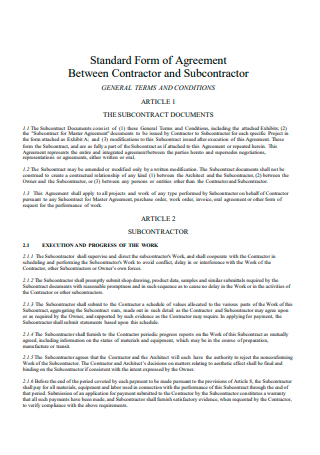
Standard Form of Subcontractor Agreement
download now -
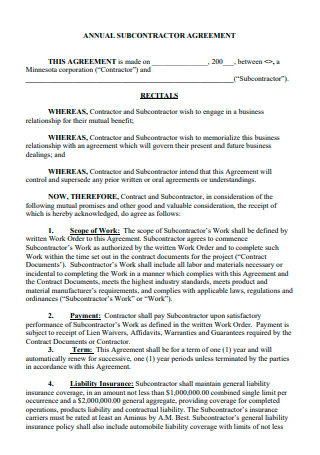
Standard Annual Subcontractor Agreement
download now -

Standard Construction Subcontractor Agreement
download now -
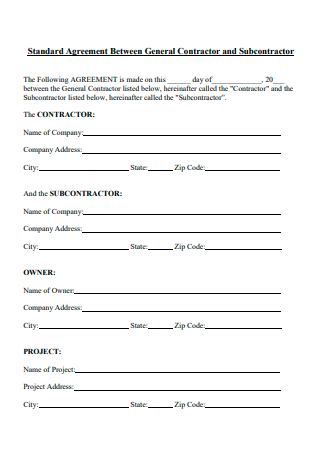
Standard Agreement Between General Contractor and Subcontractor
download now -
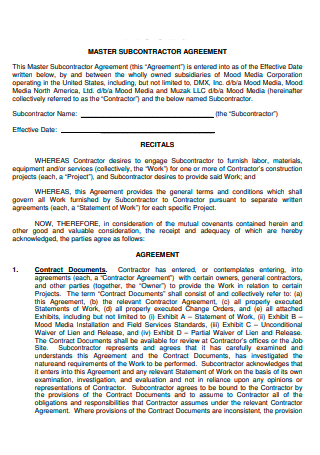
Standard Master Subcontractor Agreement
download now -

Standard Roofing Subcontractor Agreement
download now -
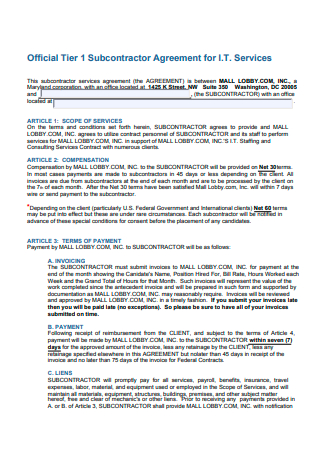
Standard Subcontractor Agreement For IT Services
download now -
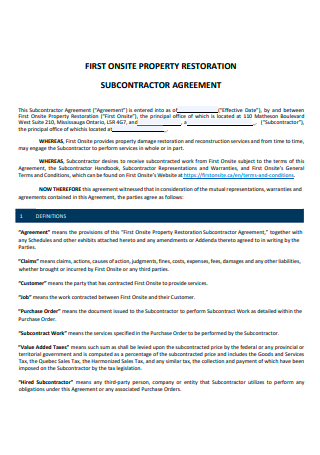
Standard Property Restoration Subcontractor Agreement
download now -
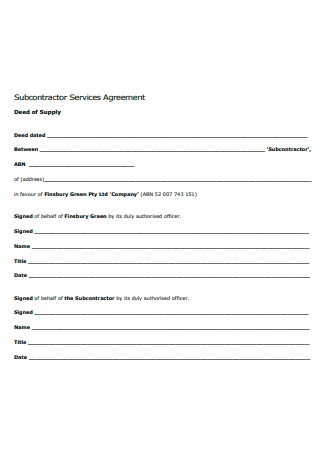
Standard Subcontractor Service Agreement
download now
FREE Standard Subcontractor Agreement s to Download
8+ Sample Standard Subcontractor Agreement
What Is a Standard Subcontractor Agreement?
What Is the Importance of a Standard Subcontractor Agreement?
What Should be in a Standard Subcontractor Agreement?
When to Use a Standard Subcontractor Agreement?
What Is the Benefit of Standard Subcontractor Agreement?
Why Is a Standard Subcontractor Agreement Necessary?
Elements of Standard Subcontractor Agreement
How to Write a Standard Subcontractor Agreement
FAQs
Are subcontractors classed as employees?
Can I modify the subcontractor agreement template?
Who is the first part of a subcontractor agreement?
What Is a Standard Subcontractor Agreement?
Whether the services are given to the business itself or to its customers, this typical subcontractor agreement may be used whenever a firm needs to employ a subcontractor to deliver services (such as information technology services). It is referred to as a framework agreement in the sense that the signing of the agreement does not impose any duties in terms of services. Instead, the contract serves as a framework within which the parties can enter into individual statements of work in connection to specific services, which are then implemented. An optional non-solicitation clause is added, which may aid in the protection of the firm against customer poaching by an errant subcontractor, if it is implemented.
Other templates are available on our website, and you can use them whenever you need them. They are as follows: general subcontractor agreement, shared services agreement, work contract, Labor Contract, position agreement, staffing agreement, business lease proposal, work agreement, property purchase agreement, project budget proposal, retail lease proposal, and other similar templates are available. This post will not only provide you with templates but will also provide you with important information that you need to know in order to complete your template.
What Is the Importance of a Standard Subcontractor Agreement?
When a contractor hires a subcontractor who then hires another subcontractor to execute work as part of a large project, the situation can become fairly convoluted very quickly. Among the risks in this situation are the possibility that details will be misinterpreted, payments will be missed, and work will not be completed on time. All of these events have the potential to cause a project to be seriously derailed. A general subcontractor agreement ensures that operations are carefully managed, targeted, and uniform across all parties engaged in the project by establishing clear expectations for all parties involved in the project.
What Should be in a Standard Subcontractor Agreement?
Among the many aspects of the agreement that will be covered are: specifying the obligations of the subcontractor; specifying the payment details for the subcontractor; specifying what performance is required of the subcontractor; specifying the termination of the agreement; and guidelines for approaching and resolving disputes. The Standard Subcontractor Agreement will be signed by both the contractor and the subcontractor. If the subcontractor is providing a one-time service, it is possible that the service will continue indefinitely. It is possible for a contractor to opt to enter into a Standard Subcontractor Agreement (SSA) with a subcontractor when they are engaged in a project and require specialized skills or contributions that will not be required on an ongoing basis. Subcontractors can be used as a versatile tool to assist in the completion of a certain task or result.
When to Use a Standard Subcontractor Agreement?
Subcontractor agreements may be necessary on a frequent basis depending on the size and extent of your company’s activities and projects. A standard subcontractor agreement will be necessary each time you outsource services in order to complete a project, regardless of the size of the project. When it comes to being a contractor or project manager, you most likely have a clear understanding of where you stand in terms of your ability to finish a job. If you are taking on a new customer, you may want to reach out to your network to find subcontractors in order to ensure that the job is completed on time. A standard subcontractor agreement will also be required if your present subcontractors are no longer able to perform their obligations and you need to recruit new subcontractors to take their place. Finally, if additional time is required to accomplish the assignment, you may be forced to use general subcontractor agreements to extend the period of the contracts in order to complete the task.
What Is the Benefit of Standard Subcontractor Agreement?
Before entering into a general subcontractor agreement with another contractor, a contractor should take a number of considerations into consideration. To begin, the contractor must determine whether or not the client is willing to authorize subcontracted work before proceeding. In the event when a contractor and a client enter into an agreement to complete a project, the contractor and the client are considered to be in a contractual relationship. As the name implies, the contract is known as a Standard Subcontract Agreement. The customer will specify in that master agreement whether or not the contractor is permitted to subcontract any aspect of the project. If this is not indicated in the agreement, it should be assumed that the client does not intend the job to be finished by anybody other than the original contractor who was hired to execute the work.
If the Standard Subcontract Agreement bans the contractor from recruiting subcontractors, the contractor is legally compelled to follow by the terms of the agreement, regardless of the circumstances. The Standard Subcontract Agreement must have specific text that defines the roles and obligations of the contractors and subcontractors involved in the project. The contracting party must be indemnified for any errors or damage caused by the work of a subcontractor under the terms of the contract. If this legal language is not included in the contract, the contractor may be held accountable for any damages or errors that occur. Corporations and small company owners are all included.
Why Is a Standard Subcontractor Agreement Necessary?
Every business has its own standards to adhere to. In order to effectively manage your projects, no matter what type of project you are working on, you will need to set some essential rules in place. When it comes to contracts, the most important thing to remember is that they must be in writing, because verbal agreements are not often viewed as legally binding or meaningful. It is necessary to document the set of instructions that will govern the relationship between you and the subcontractors who will be hired by you in order to accomplish this. The agreement ensures that there will always be regulations to follow, regardless of the situation. Because you will be working under written terms, it will be more difficult for anyone involved in the arrangement to breach the terms and conditions of the business agreement than it would be otherwise.
Elements of Standard Subcontractor Agreement
In order to govern your business connection with the subcontractor you have chosen, you must establish a subcontract agreement. Using the template supplied below, you may put together a plan for the agreement. For drafting a good subcontractor agreement, the following three recommended practices should be followed.
How to Write a Standard Subcontractor Agreement
There are various provisions in a basic subcontractor agreement template, and each of the sections is written in succinct and professional language. In order to avoid any confusion or ambiguities in the future, the terms of the subcontract agreement format should be written in a clear and concise manner. This clarity ensures that all of the parties that agree to the provisions of the subcontractor agreement are legally protected from each other. The following are the processes to follow while writing a conventional subcontractor agreement:
-
Step 1: The Project’s Scope
This section of the agreement details the work required and the scope of the project as a whole. It encompasses the client’s requirements, the subcontractor’s responsibilities, and your own expectations as a contractor.
-
Step 2: Date of Completion
The agreement will specify how much more time you will provide for subcontractors to finish their work. By specifying a deadline that is well in advance of your own, you ensure that you will have sufficient time to review the work produced by the subcontractor. The assurance of quality work provides peace of mind for both you and the client.
-
Step 3: Payment and Billing Information
This section details the compensation received by the subcontractor for their job. You will pay the subcontractor based on the scope of work. If the subcontractor requires longer time to complete all of their obligations, the contract should specify any required extensions or Additional Payments.
-
Step 4: Responsibilities for Accidental Damage Insurance
In terms of insurance, you may or may not have coverage for the subcontractor’s errors, omissions, or accidental damage. If you have insurance, you must include it here. If not, this insurance clause must spell out the client’s insurance responsibilities.
Step 5: Permissions and Restrictions for Assignment
This section of the agreement enables you to set specific restrictions and permissions applicable to the subcontractor’s hiring of additional personnel to assist them in completing their work. It is not uncommon for you to impose boundaries on your hired subcontractor in order to avoid spreading the line of work’s obligations too thinly.
-
Step 6: Warranties
This part must include any assurances made by you to the subcontractor and vice versa.
As a result, you must select subcontractors to perform all or a portion of the work necessary to finish your client’s project. A typical agreement with a subcontractor should detail the subcontractor’s liabilities, responsibilities, and tasks, as well as any additional terms or conditions agreed upon by both parties.
FAQs
Are subcontractors classed as employees?
A subcontractor is not an employee. Subcontractors are independent contractors who do not work for the contractor and who select how to do their job.
Can I modify the subcontractor agreement template?
Recognize that agreements may need to be amended due to project scope. That’s why our template is available in Word and PDF formats.
Who is the first part of a subcontractor agreement?
First, the Contractor is defined. Entity responsible for signing the customer contract and hiring the Subcontractor.
Subcontractors are businesses that perform work on behalf of the major contractors in the building industry. These companies typically have particular skills or equipment that contractors do not have, or their business models may be such that you, as the principal contractor, outsource all of your work. You hire a subcontractor for this reason, in the first place. If you’re intending to hire a subcontractor for your project, you’ll need to put together a standard subcontractor agreement to protect your interests.
